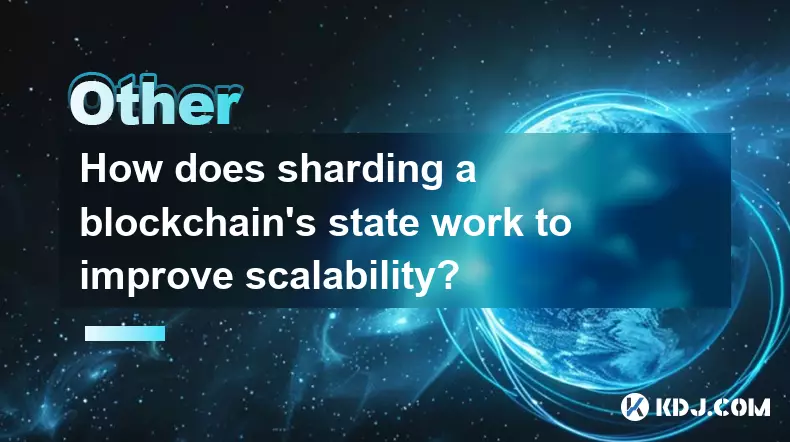-
 bitcoin
bitcoin $99296.318777 USD
-2.82% -
 ethereum
ethereum $3203.465899 USD
-6.84% -
 tether
tether $0.999590 USD
-0.03% -
 xrp
xrp $2.308913 USD
-4.00% -
 bnb
bnb $922.788929 USD
-3.53% -
 solana
solana $144.020807 USD
-5.89% -
 usd-coin
usd-coin $0.999798 USD
0.00% -
 tron
tron $0.291590 USD
-1.12% -
 dogecoin
dogecoin $0.163780 USD
-4.46% -
 cardano
cardano $0.526919 USD
-4.40% -
 hyperliquid
hyperliquid $37.888865 USD
-2.24% -
 bitcoin-cash
bitcoin-cash $510.515457 USD
-1.08% -
 chainlink
chainlink $14.436987 USD
-5.63% -
 stellar
stellar $0.267345 USD
-4.77% -
 unus-sed-leo
unus-sed-leo $9.175222 USD
0.53%
How does sharding a blockchain's state work to improve scalability?
State sharding boosts blockchain scalability by splitting the network into parallel-processing shards, reducing node load and enabling high throughput while maintaining security.
Nov 12, 2025 at 10:40 pm

Understanding State Sharding in Blockchain Networks
1. Blockchain networks face inherent limitations when handling large volumes of transactions due to the requirement that every node processes and stores the entire state. This creates a bottleneck, especially as user activity grows. State sharding addresses this by partitioning the blockchain's global state into smaller, manageable segments called shards. Each shard maintains its own subset of accounts and smart contracts, enabling parallel processing across the network.
2. Instead of requiring all nodes to validate every transaction, state sharding assigns validator nodes to specific shards. These validators only process transactions relevant to their assigned shard, drastically reducing computational load per node. This division allows multiple shards to execute transactions simultaneously, increasing throughput without demanding more from individual nodes.
3. Communication between shards is managed through cross-shard transactions, which are coordinated using cryptographic proofs or beacon chains. When an account in one shard needs to interact with another, a verification mechanism ensures data consistency and prevents double-spending. Protocols like Ethereum 2.0 use a central beacon chain to orchestrate shard synchronization and manage validator assignments.
4. Data availability becomes critical in sharded systems. Nodes must ensure that each shard’s state data remains accessible for auditing and validation. Techniques such as erasure coding and data sampling allow lightweight nodes to verify that full data has been published without downloading entire shard histories, preserving decentralization and security.
5. By distributing both computation and storage across independent shards, state sharding fundamentally restructures how blockchains scale—transforming linear processing into a parallelized architecture capable of supporting millions of users without sacrificing security.
Key Components Enabling Effective State Sharding
1. Shard chains operate as semi-independent blockchains, each maintaining its own transaction history and state root. They run consensus mechanisms locally, often using proof-of-stake variants, where selected validators propose and attest to blocks within their shard.
2. A top-level coordination layer, such as a beacon chain, oversees the entire sharded ecosystem. It randomly assigns validators to shards to prevent targeted attacks, manages crosslinks (references to shard blocks), and ensures system-wide finality through periodic checkpoints.
3. Cryptographic commitments like Merkle roots enable efficient verification of cross-shard transactions. When funds move from Shard A to Shard B, a receipt is generated in Shard A and included in Shard B’s block, allowing recipients to confirm the transfer’s validity without accessing the source shard directly.
4. Economic incentives align validator behavior across shards. Staking requirements and slashing conditions deter malicious activity, ensuring that even though nodes specialize in particular shards, the overall network remains secure and trustworthy.
Challenges and Trade-offs in Sharded Architectures
1. Cross-shard communication introduces latency and complexity. Transactions spanning multiple shards require multi-step confirmation protocols, potentially slowing down interactions compared to intra-shard operations. Designers must balance efficiency with atomicity to avoid partial failures.
2. Rebalancing shards poses logistical difficulties. As usage patterns shift, some shards may become overloaded while others remain underutilized. Dynamic resharding—moving accounts or state between shards—is technically challenging and risks disrupting ongoing operations.
3. Security distribution varies across shards. Smaller shards with fewer validators are more vulnerable to takeover attempts. Random validator rotation and cryptoeconomic safeguards help mitigate this risk but cannot eliminate it entirely.
4. User experience complications arise when managing assets across shards. Wallets and dApps must handle inter-shard transfers seamlessly, requiring new standards for addressing, routing, and confirming transactions beyond traditional single-chain models.
5. Despite these hurdles, state sharding remains one of the most promising paths toward blockchain scalability, offering exponential gains in throughput while preserving core principles of decentralization and trustlessness.
Frequently Asked Questions
What prevents a shard from being compromised by malicious validators?Shards employ random validator selection and frequent reshuffling to minimize the risk of collusion. Slashing penalties penalize dishonest behavior, making attacks economically unviable. Additionally, cryptographic proofs ensure that invalid state transitions can be challenged by honest nodes.
How do users send transactions to the correct shard?Transaction routing relies on deterministic rules based on recipient addresses. Systems map addresses to specific shards using hashing functions. Wallets and clients automatically determine the destination shard, submit the transaction accordingly, and track its inclusion via receipts.
Can smart contracts span multiple shards?Direct execution across shards is limited. Instead, contracts communicate asynchronously through message passing or relayed events. Some platforms support 'global' contracts replicated across shards, though this increases overhead. Most applications are designed to operate within a single shard for performance reasons.
Is state sharding compatible with Layer 2 solutions?Yes, state sharding complements Layer 2 scaling techniques like rollups. Individual shards can host their own rollup ecosystems, further increasing capacity. The combination enables hierarchical scaling, where each shard processes high-throughput off-chain batches before anchoring results on-chain.
Disclaimer:info@kdj.com
The information provided is not trading advice. kdj.com does not assume any responsibility for any investments made based on the information provided in this article. Cryptocurrencies are highly volatile and it is highly recommended that you invest with caution after thorough research!
If you believe that the content used on this website infringes your copyright, please contact us immediately (info@kdj.com) and we will delete it promptly.
- Mohammed Siraj's First Spell Woes: An India Teammate's Critique
- 2025-11-14 14:40:02
- BTC, ETH, and Altcoin Picks: Navigating the Crypto Landscape
- 2025-11-14 14:50:01
- Coin Toss Tales: Temba Bavuma's Wager and India vs. SA Showdown
- 2025-11-14 12:50:01
- Canary XRP ETF and Solana ETF: First-Day Activity Heats Up the Crypto ETF Race
- 2025-11-14 12:20:01
- Vitalik Buterin, Zero-Knowledge Proofs, and the Whitelist: A New Era of Trustless Crypto?
- 2025-11-14 09:00:01
- Cryptos in the Spotlight: Zero Knowledge Proof, Dogecoin, and the Shifting Tides
- 2025-11-14 08:45:01
Related knowledge

What are the risks of investing in blockchain projects?
Nov 14,2025 at 10:19am
Risks Associated with Volatility in Cryptocurrency Markets1. The price of digital assets can shift dramatically within minutes due to speculation, new...

How does blockchain enable decentralized finance (DeFi)?
Nov 14,2025 at 07:59am
Understanding the Role of Blockchain in DeFi Infrastructure1. Blockchain serves as the foundational layer for decentralized finance by offering a dist...

What are gas fees on the Ethereum blockchain?
Nov 14,2025 at 09:00am
Understanding Gas Fees on the Ethereum Network1. Gas fees are payments made by users to compensate for the computational energy required to process an...

What are the main advantages of using blockchain technology?
Nov 14,2025 at 08:40am
Enhanced Security and Data Integrity1. Blockchain uses cryptographic hashing to secure each block, making it nearly impossible to alter data without d...

What are intents in crypto and how do they change user interaction?
Nov 09,2025 at 09:00am
Understanding the Role of Decentralized Exchanges in Modern Crypto Trading1. Decentralized exchanges, commonly known as DEXs, have reshaped how trader...

What is restaking and how does it enhance economic security?
Nov 09,2025 at 11:40pm
Understanding Restaking in the Blockchain Ecosystem1. Restaking refers to the process where users who have already staked their tokens in a proof-of-s...

What are the risks of investing in blockchain projects?
Nov 14,2025 at 10:19am
Risks Associated with Volatility in Cryptocurrency Markets1. The price of digital assets can shift dramatically within minutes due to speculation, new...

How does blockchain enable decentralized finance (DeFi)?
Nov 14,2025 at 07:59am
Understanding the Role of Blockchain in DeFi Infrastructure1. Blockchain serves as the foundational layer for decentralized finance by offering a dist...

What are gas fees on the Ethereum blockchain?
Nov 14,2025 at 09:00am
Understanding Gas Fees on the Ethereum Network1. Gas fees are payments made by users to compensate for the computational energy required to process an...

What are the main advantages of using blockchain technology?
Nov 14,2025 at 08:40am
Enhanced Security and Data Integrity1. Blockchain uses cryptographic hashing to secure each block, making it nearly impossible to alter data without d...

What are intents in crypto and how do they change user interaction?
Nov 09,2025 at 09:00am
Understanding the Role of Decentralized Exchanges in Modern Crypto Trading1. Decentralized exchanges, commonly known as DEXs, have reshaped how trader...

What is restaking and how does it enhance economic security?
Nov 09,2025 at 11:40pm
Understanding Restaking in the Blockchain Ecosystem1. Restaking refers to the process where users who have already staked their tokens in a proof-of-s...
See all articles










































































